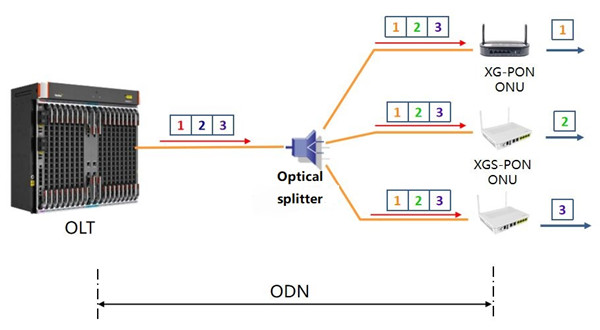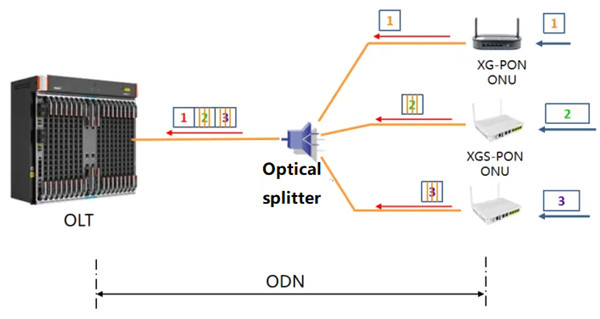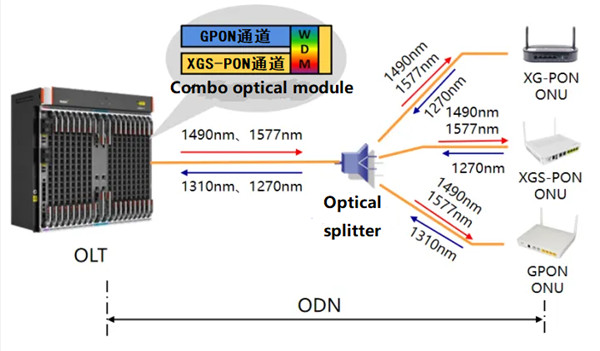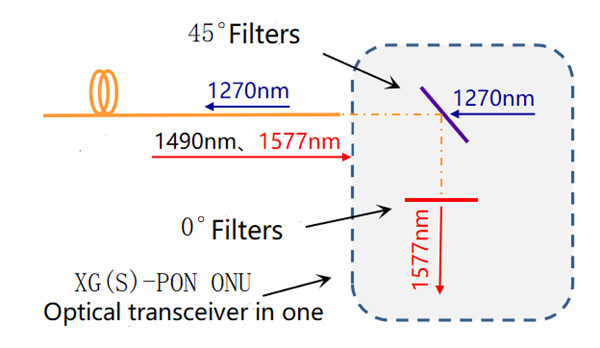XG-PON and XGS-PON both belong to the GPON series, and from the technical roadmap, XGS-PON is the technological evolution of XG-PON.

XG-PON and XGS-PON are both 10G PON, the main differences are: XG-PON is asymmetric PON, and the up/down rate of the PON port is 2.5G/10G; XGS-PON is symmetrical PON, and the up/downstream rate of the PON port is 10G/10G.
|
technology |
GPON |
XG-PON |
XGS-PON |
|
|
Technical standards |
G.984 |
G.987 |
G.9807.1 |
|
|
The year the standard was published |
2003 |
2009 |
2016 |
|
|
Line rate(Mbps) |
Downlink |
2448 |
9953 |
9953 |
|
Uplink |
1244 |
2448 |
9953 |
|
|
Maximum split ratio |
128 |
256 |
256 |
|
|
Maximum transmission distance(Km) |
20 |
40 |
40 |
|
|
Data encapsulation |
GEM |
XGEM |
XGEM |
|
|
Available bandwidth(Mbps) |
Downlink |
2200 |
8500 |
8500 |
|
Uplink |
1800 |
2000 |
8500 |
|
|
Operating wavelength(nm) |
Downlink |
1490 |
1577 |
|
|
Uplink |
1310 |
1270 |
||
The main PON technologies currently in use are GPON and XG-PON, both GPON and XG-PON are asymmetric PON. Since the up/down data of users is generally asymmetric, taking a certain tier city as an example, the uplink traffic of OLT is only 22% of the downlink on average, so the technical characteristics of asymmetric PON basically match the needs of users. More importantly, the uplink rate of asymmetric PON is low, the cost of transmitting components such as lasers in the ONU is lower, and the equipment cost is correspondingly lower.
The coexistence of XGS-PON with XG-PON and GPON,XGS-PON is a technical evolution of GPON and XG-PON, which supports mixed access of GPON, XG-PON and XGS-PON.
XGSPON technology
The downlink of XGS-PON adopts the broadcast method, and the uplink adopts the TDMA method.
Since the downlink wavelength and downlink rate of XGS-PON and XG-PON are the same, the downlink of XGS-PON does not distinguish between XGS-PON ONU and XG-PON ONU, the optical splitter broadcasts the downstream optical signal to each XG(S)-PON (XG-PON and XGS-PON) ONU in the same ODN link, and each ONU chooses to receive its own signal and discard other signals.

The upstream of the XGS-PON transmits data according to the time slot, and the ONU sends data within the OLT-licensed time slot. OLT is based on the traffic requirements of different ONUs and the type of ONU. Dynamically allocate time slots. The data transmission rate is 2.5Gbps in the time slot allocated to the XG-PON ONU, and 10Gbps in the time slot allocated to the XGS-PON ONU.

Since the up/down wavelength is different from GPON, XGS-PON uses the Combo scheme to share ODN with GPON.
XGS-PON's Combo optical module integrates GPON optical module, XGS-PON optical module and WDM combiner.
In the uplink direction, after the optical signal enters the XGS-PON Combo port, WDM filters the GPON signal and the XGS-PON signal according to the wavelength, and then sends the signal to different channels.

In the downlink direction, the signal from the GPON & XGS-PON channel is multiplexed through WDM, and the mixed signal is downlink to the ONU through the ODN, and because the wavelengths are different, different types of ONUs select their desired wavelengths through internal filters to receive signals.

Since XGS-PON naturally supports coexistence with XG-PON, the Combo solution of XGS-PON supports the mixed access of GPON, XG-PON and XGS-PON, and the Combo optical module of XGS-PON is also called a three-mode Combo optical module (while the Combo optical module of XG-PON is called a two-mode Combo optical module because it supports the mixed access of GPON and XG-PON).
To keep you far ahead of others, we suggest you to adopt our XGXPON OLT LM808XGS, more details please browse our web: www.limeetech.com
Post time: Dec-01-2022






